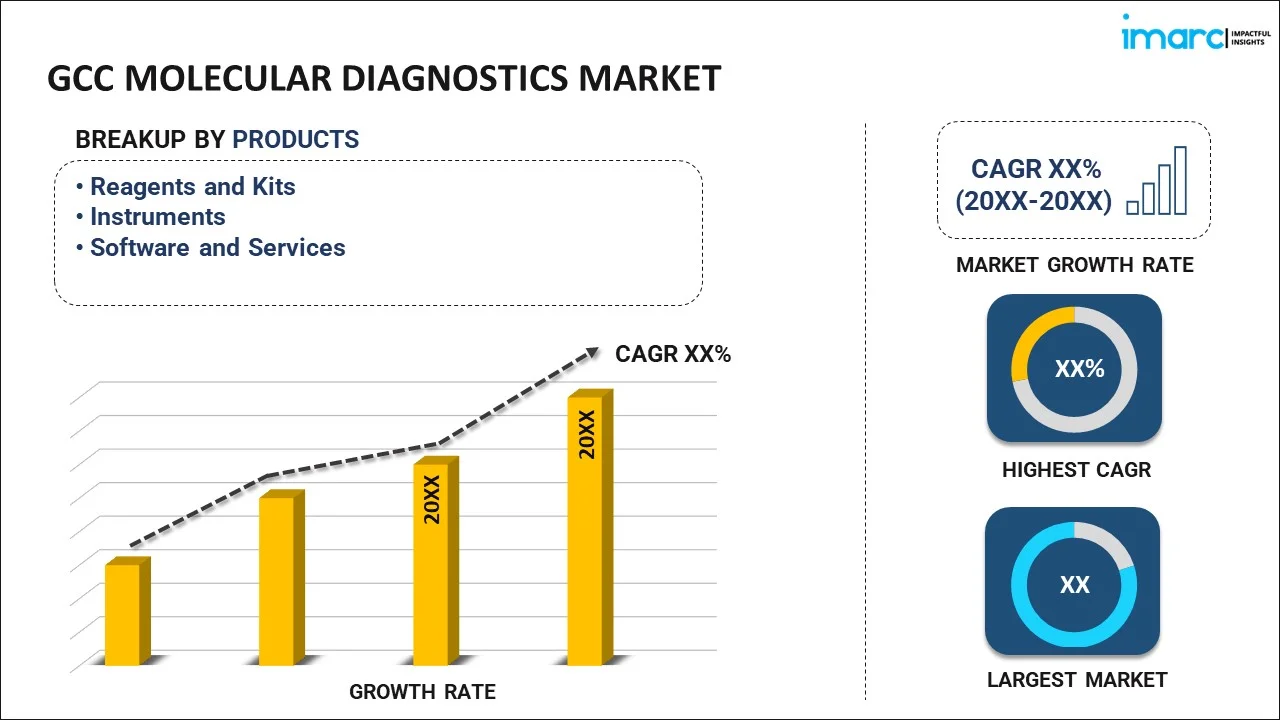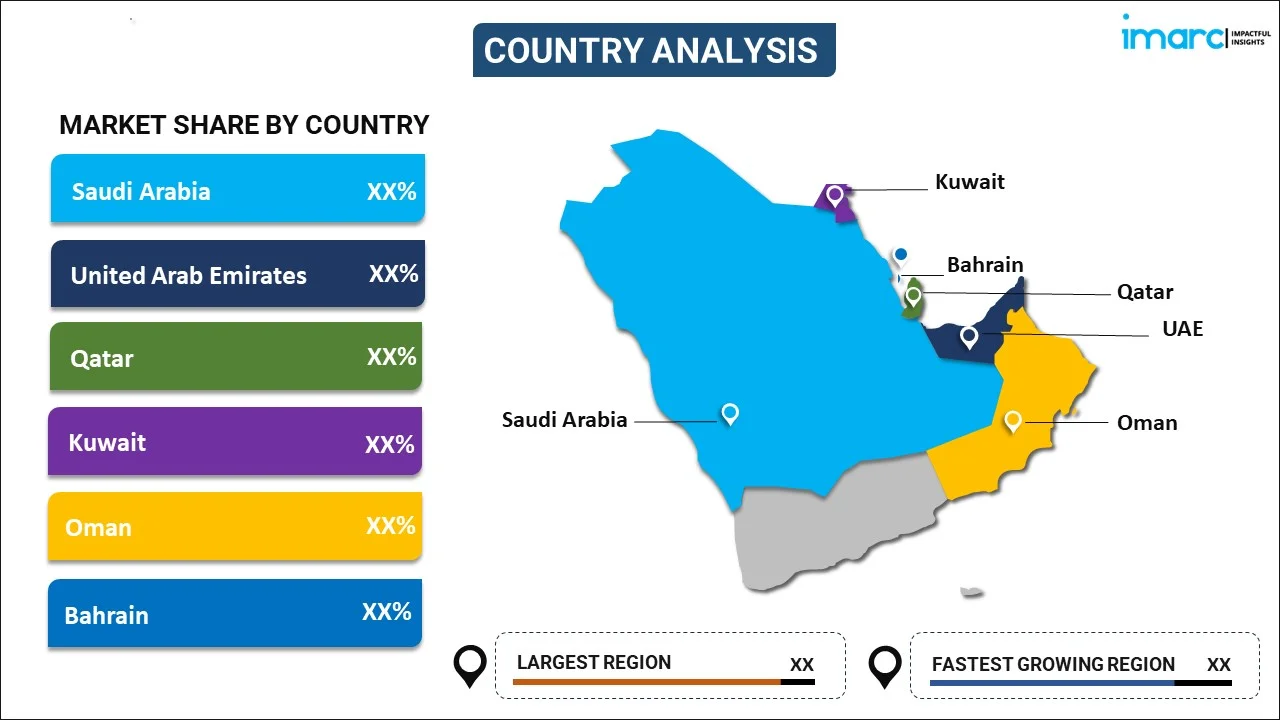
GCC Molecular Diagnostics Market Report by Product (Reagents and Kits, Instruments, Software and Services), Technology (Polymerase Chain Reactions (PCR), Hybridization, DNA Sequencing, Microarray, Isothermal Nucleic Acid Amplification Technology (INAAT), and Others), Application (Infectious Diseases Diagnostics, Oncology, Genetic Testing, Blood Screening, and Others), End User (Hospitals, Laboratories, and Others), and Country 2025-2033
Market Overview:
The GCC molecular diagnostics market size is projected to exhibit a growth rate (CAGR) of 6.67% during 2025-2033. The increasing prevalence of chronic diseases, favorable government initiatives, growing healthcare awareness, rising focus on developing eco-friendly variations, rapid technological advancements and widespread investment in healthcare infrastructure represent some of the key factors driving the market.
|
Report Attribute
|
Key Statistics
|
|---|---|
|
Base Year
|
2024
|
|
Forecast Years
|
2025-2033
|
|
Historical Years
|
2019-2024
|
| Market Growth Rate (2025-2033) | 6.67% |
Molecular diagnostics is a cutting-edge branch of medical science focused on detecting and measuring particular genetic sequences in deoxyribonucleic acid (DNA) and ribonucleic acid (RNA), which may be related to certain diseases. It allows precise identification and characterization of various diseases at the molecular level. Molecular diagnostics utilizes techniques, such as polymerase chain reaction (PCR), in situ hybridization, DNA sequencing, and other nucleic acid technologies that help in the early detection, prognosis, and treatment planning of a broad spectrum of conditions, including infections, cancers, genetic disorders, and others. Moreover, molecular diagnostics is vital in advancing personalized healthcare solutions, owing to its accuracy, speed, and reliability.
GCC Molecular Diagnostics Market Trends:
The growing prevalence of infectious diseases, chronic conditions, and genetic disorders in the region, prompting the need for accurate and timely diagnostics, is one of the major factors creating a positive outlook for the market. Furthermore, the increasing investment in healthcare infrastructure, government initiatives to promote medical research, and technological advancements in diagnostic methodologies are providing a considerable boost to the market growth. Moreover, the rise in healthcare awareness and accessibility to advanced diagnostic facilities is also supporting the market growth. In addition to this, the introduction of personalized medicine and targeted therapies, catering to patient-specific needs, is creating a positive outlook for the market growth. Additionally, the growing emphasis on early detection, prevention, and evidence-based treatment approaches is also acting as a growth-inducing factor. In confluence with this, the rising focus on developing eco-friendly, cost-effective diagnostic techniques that align with global sustainability trends is providing a thrust to the market growth. Besides this, the increasing collaboration between healthcare institutions, diagnostic laboratories, and research organizations within the region, fostering innovation, is positively impacting the market growth. Furthermore, the growing emphasis on preventive healthcare as the medical sector in the region shift from treatment-focused to prevention-focused models leading to the adoption of molecular diagnostics due to its ability to provide early and precise information, is propelling the market growth. Apart from this, the integration of artificial intelligence (AI) and machine learning (ML) in diagnostic procedures to enhance the efficiency and accuracy of molecular diagnostic tests is providing an impetus to the market growth.
GCC Molecular Diagnostics Market Segmentation:
IMARC Group provides an analysis of the key trends in each segment of the GCC molecular diagnostics market report, along with forecasts at the regional and country levels for 2025-2033. Our report has categorized the market based on product, technology, application and end user.
Product Insights:

- Reagents and Kits
- Instruments
- Software and Services
The report has provided a detailed breakup and analysis of the market based on the product. This includes reagents and kits, instruments and software and services.
Technology Insights:
- Polymerase Chain Reactions (PCR)
- Hybridization
- DNA Sequencing
- Microarray
- Isothermal Nucleic Acid Amplification Technology (INAAT)
- Others
The report has provided a detailed breakup and analysis of the market based on the technology. This includes polymerase chain reactions (PCR), hybridization, DNA sequencing, microarray, isothermal nucleic acid amplification technology (INAAT) and others.
Application Insights:
- Infectious Diseases Diagnostics
- Oncology
- Genetic Testing
- Blood Screening
- Others
A detailed breakup and analysis of the market based on the application has also been provided in the report. This includes infectious diseases diagnostics, oncology, genetic testing, blood screening and others.
End User Insights:
- Hospitals
- Laboratories
- Others
A detailed breakup and analysis of the market based on the end user has also been provided in the report. This includes hospitals, laboratories and others.
Country Insights:

- Saudi Arabia
- UAE
- Qatar
- Bahrain
- Kuwait
- Oman
The report has also provided a comprehensive analysis of all the major regional markets, which include Saudi Arabia, the UAE, Qatar, Bahrain, Kuwait and Oman.
Competitive Landscape:
The report has also provided a comprehensive analysis of the competitive landscape in the market. Competitive analysis such as market structure, key player positioning, top winning strategies, competitive dashboard, and company evaluation quadrant has been covered in the report. Also, detailed profiles of all major companies have been provided.
GCC Molecular Diagnostics Market Report Coverage:
| Report Features | Details |
|---|---|
| Base Year of the Analysis | 2024 |
| Historical Period | 2019-2024 |
| Forecast Period | 2025-2033 |
| Units | Million USD |
| Scope of the Report | Exploration of Historical and Forecast Trends, Industry Catalysts and Challenges, Segment-Wise Historical and Predictive Market Assessment:
|
| Products Covered | Reagents and Kits, Instruments, Software and Services |
| Technologies Covered | Polymerase Chain Reactions (PCR), Hybridization, DNA Sequencing, Microarray, Isothermal Nucleic Acid Amplification Technology (INAAT), Others |
| Applications Covered | Infectious Diseases Diagnostics, Oncology, Genetic Testing, Blood Screening, Others |
| End Users Covered | Hospitals, Laboratories, Others |
| Countries Covered | Saudi Arabia, UAE, Qatar, Bahrain, Kuwait, Oman |
| Customization Scope | 10% Free Customization |
| Post-Sale Analyst Support | 10-12 Weeks |
| Delivery Format | PDF and Excel through Email (We can also provide the editable version of the report in PPT/Word format on special request) |
Key Questions Answered in This Report:
- How has the GCC molecular diagnostics market performed so far and how will it perform in the coming years?
- What has been the impact of COVID-19 on the GCC molecular diagnostics market?
- What is the breakup of the GCC molecular diagnostics market on the basis of product?
- What is the breakup of the GCC molecular diagnostics market on the basis of technology?
- What is the breakup of the GCC molecular diagnostics market on the basis of application?
- What is the breakup of the GCC molecular diagnostics market on the basis of end user?
- What are the various stages in the value chain of the GCC molecular diagnostics market?
- What are the key driving factors and challenges in the GCC molecular diagnostics market?
- What is the structure of the GCC molecular diagnostics market and who are the key players?
- What is the degree of competition in the GCC molecular diagnostics market?
Key Benefits for Stakeholders:
- IMARC’s report offers a comprehensive quantitative analysis of various market segments, historical and current market trends, market forecasts, and dynamics of the GCC molecular diagnostics market from 2019-2033.
- The research study provides the latest information on the market drivers, challenges, and opportunities in the GCC molecular diagnostics market.
- Porter's five forces analysis assist stakeholders in assessing the impact of new entrants, competitive rivalry, supplier power, buyer power, and the threat of substitution. It helps stakeholders to analyze the level of competition within the GCC molecular diagnostics industry and its attractiveness.
- Competitive landscape allows stakeholders to understand their competitive environment and provides an insight into the current positions of key players in the market.
Need more help?
- Speak to our experienced analysts for insights on the current market scenarios.
- Include additional segments and countries to customize the report as per your requirement.
- Gain an unparalleled competitive advantage in your domain by understanding how to utilize the report and positively impacting your operations and revenue.
- For further assistance, please connect with our analysts.
 Inquire Before Buying
Inquire Before Buying
 Speak to an Analyst
Speak to an Analyst
 Request Brochure
Request Brochure
 Request Customization
Request Customization




.webp)




.webp)












